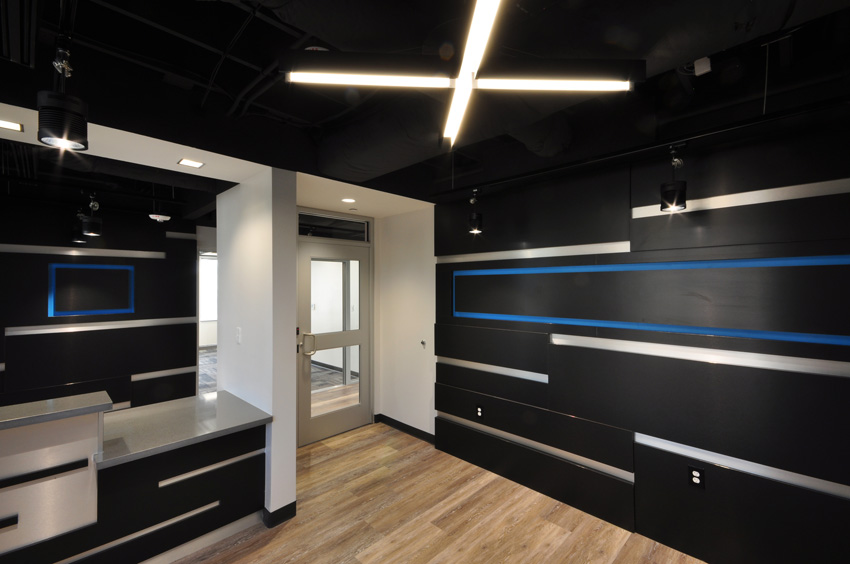Hard Walls, High Style
Decorative protection panels bring style, durability, resiliency, and safety to commercial settings
![]() Continuing Education
Continuing Education
Use the following learning objectives to focus your study while reading this month’s Continuing Education article.
Learning Objectives - After reading this article, you will be able to:
- Discuss the need for durable, decorative panels for commercial, retail, health care, education, food service, and other settings.
- Describe types of wall-protection products and their strengths and weaknesses.
- Review testing, standards, and certifications for protective wall panels.
- Identify the testing, standards, and certifications of high-tech laminate panels with a fiberglass core.
- List a variety of other laminate choices for vertical surfaces, including metal laminates, writable laminates, and custom laminates.
Hard Walls for Challenging Commercial Settings
While design and aesthetics serve as hallmarks for superior projects, another factor is becoming increasingly vital in commercial spaces: durability. If the decor is not durable—if the paint peels or walls become dented within a short time—the project cannot be called a success, and it will not reflect well on the designers and builders. For many projects, the missing puzzle piece for stylish durability is decorative protection panels on vertical surfaces.
“Today’s commercial spaces need to be strong enough to stand up to the rigors of daily use, while also providing an inviting and beautiful decor,” says Renee Hytry Derrington, global design lead at Formica Corporation. “With decorative protection panels, there is no trade-off between aesthetics and durability. It offers the highest level of fire protection and supreme durability, while allowing design professionals to create interiors that reflect the latest color and design trends.”
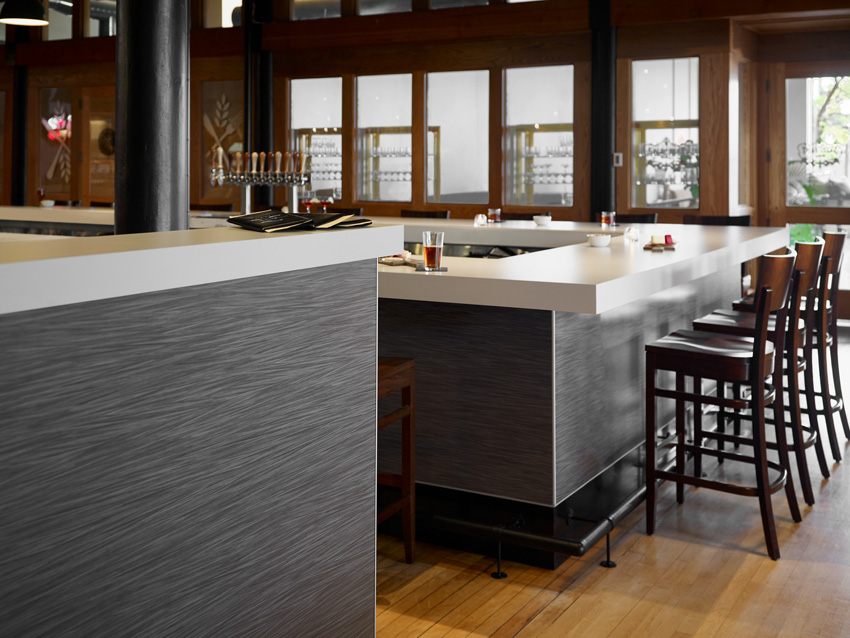
All images courtesy of Formica Group
Next-generation decorative protection panels on vertical surfaces are made durable with a fiberglass core and available in a full range of colors and patterns.
Durability is certainly a concern of architects and others in the design and build industry. In a survey of educational courses hosted by Architectural Record, nearly 150 of them focus in part on durability.
Application for Durable Vertical Surfaces
Many commercial settings benefit from durable vertical surfaces.
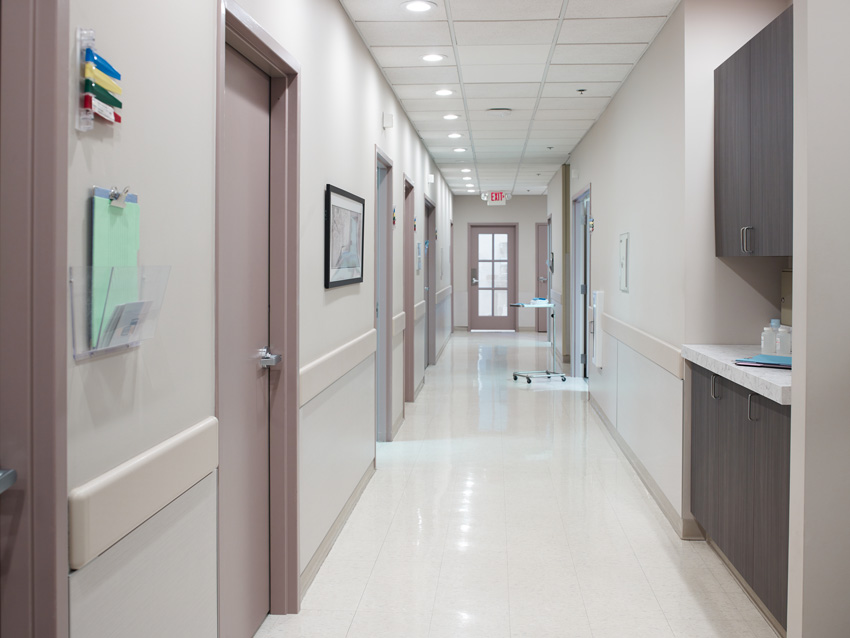
Health-care applications include corridors, nurses’ stations, entrance areas, waiting rooms, patient rooms, labs, and procedure rooms.
Health-care facilities present many challenges for the designer. Consider the traditional hospital hallway or corridor. In a typical day in a busy facility, patients on gurneys might be rushed along the corridor into emergency surgery. Large hospital beds connected to IV stands might be moved along the corridor. Nurses with carts move up and down the hallways.
It is easy to imagine the walls getting bumped into many times a day. Thus, the walls must not only be cleanable but also durable.
And consider the multitudes of people coming in and out of the facility every day, including patients arriving and being discharged, family members and visitors, delivery people, plus doctors, nurses, and other staff members. Hardworking and easy-to-clean surfaces are necessary in these settings.
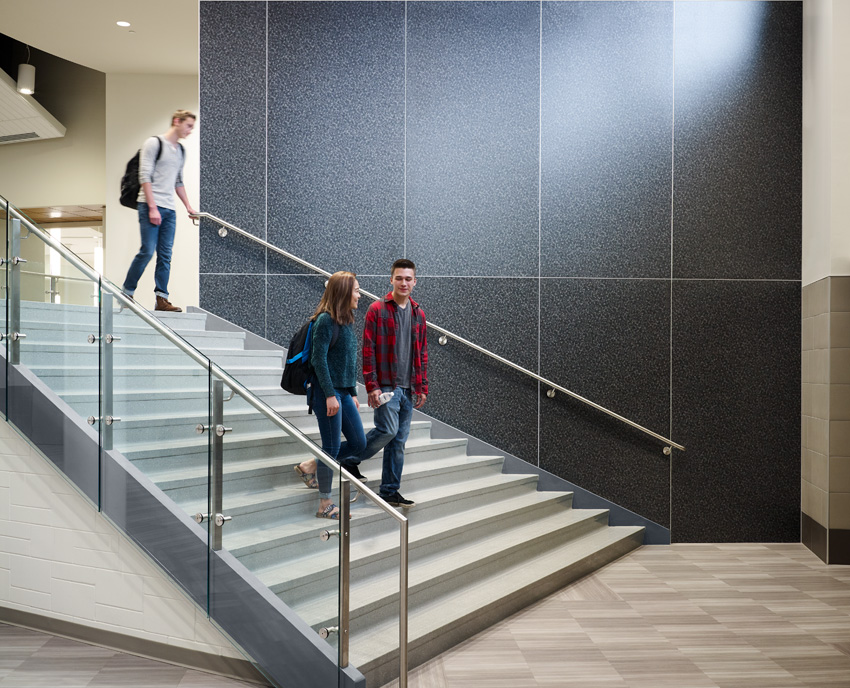
Education applications include dorm rooms, corridors, gyms, daycare centers, restrooms, and locker rooms.
Much is asked of today’s students. Being cautious and careful around the decor should not be a priority. Rather, the decor should accommodate the activity of students. Consider the use by students of dorm rooms, classrooms, cafeterias, corridors, gyms, daycare centers and restrooms. Each could benefit from durable and stylish vertical surfaces.
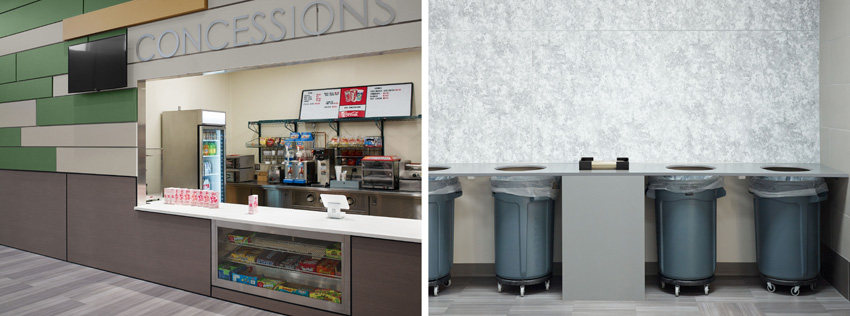
Hospitality applications include transaction counters, back of house, drink and trash areas, grocery cart areas, and displays.
Hospitality venues get a lot of rigorous use in the fast-paced industry. Meals must be cooked and served quickly, and customers and staff alike are moving quickly. The walls must be durable to take such use and retain their appearance.
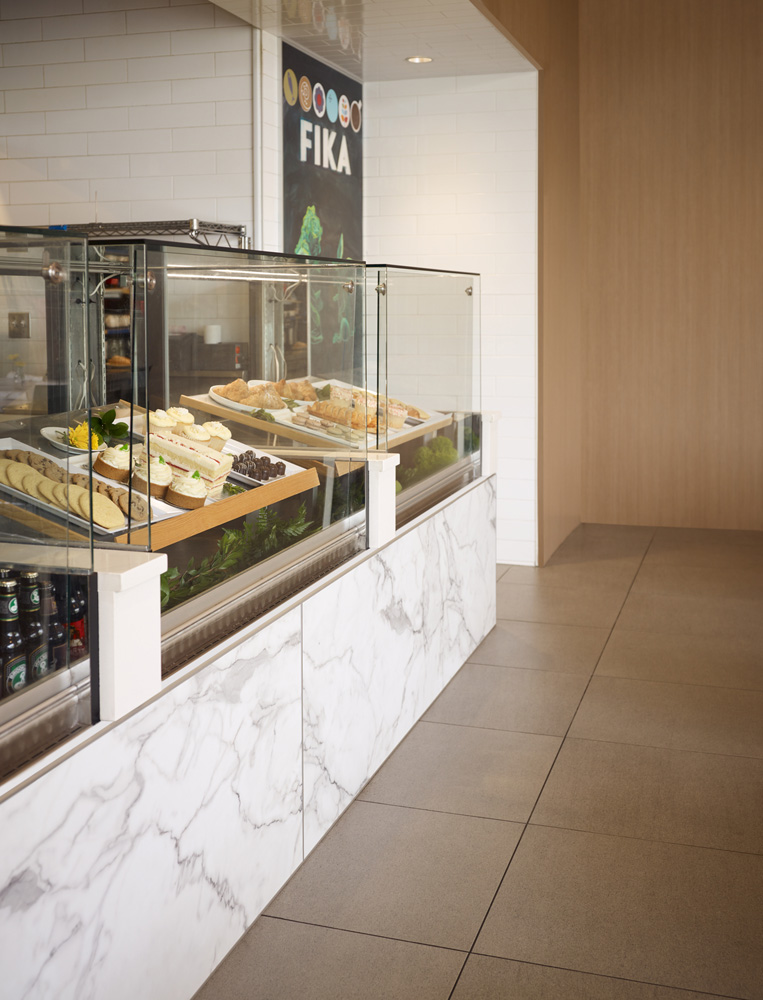
Counter fronts are frequently exposed to impact from shoes and carts. Specifying a durable vertical surface that is easy to clean could be the starting point of your next design.
Retail venues tend to be open long hours and may be busier than ever. Imagine the impacts from high traffic to which transaction counter fronts, drink stations, and back-of-house prep areas may be exposed. The ability to specify a stylish, durable vertical surface that is easy to clean could be the starting point of many design projects.
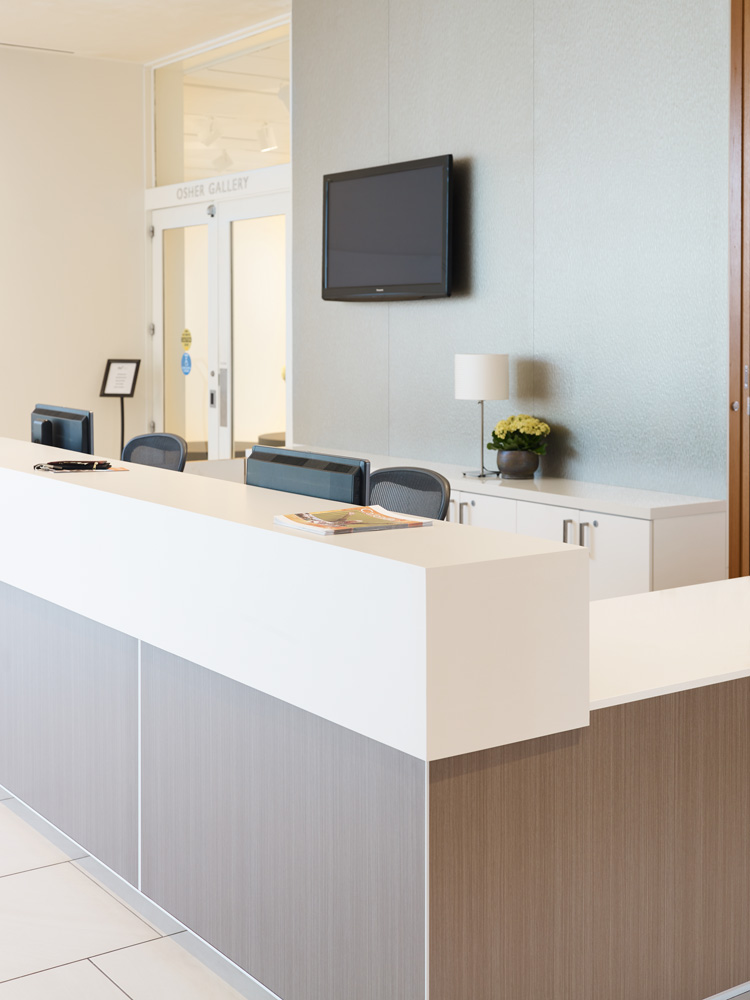
Office applications include break rooms, reception areas, foyer columns, partitions, and elevators.
In an office setting, break rooms and reception areas endure high traffic and use. A painted vertical surface that may hold up in the company president’s luxurious office may not hold up where staff members cook and enjoy meals, and waiting rooms where clients and sometimes children are received. Those vertical surfaces require a different type of treatment.
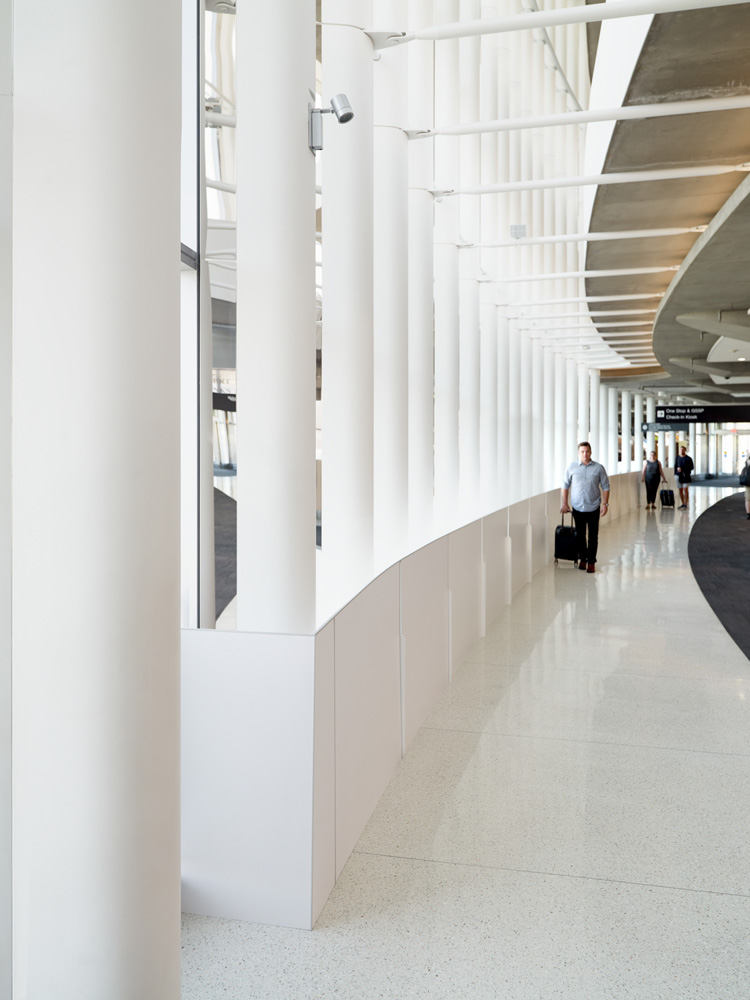
A busy airport with travelers and their luggage is a perfect application for durable wall-protection panels.
When a monumental building such as a museum or government center is designed and built, the anticipation may be that hundreds or thousands of people will visit each day. The building’s grand stairwells and wide corridors must not just be of sufficient size to accommodate the crowds, but their surfaces must also be of sufficient strength to withstand the hustle, bustle, handprints, and contact that will surely occur. While granite or marble may seem appropriate, the budget and structural strength may not allow for the same materials that built the ancient pyramids. Instead, the designer may specify a hardworking and durable laminate that looks like stone at a fraction of the cost and weight.
Other applications include airports and mass transit applications, such as wainscoting, jet ways, and corridors. It would be hard to imagine a commercial setting more challenging to vertical surfaces than a busy airport or mass transit hub with travelers and their luggage rushing to catch a flight, train, or bus. Or they may be sitting around on a layover or waiting for a late connection. In these cases, a stylish and impact-resistant wainscoting can keep the facility looking fresh longer.
Durable and stylish vertical surfaces can be considered for an almost unlimited number of other settings, from elevators to recreation vehicles, ambulances, and stairwells. Any vertical surface that will come into contact with human activity has the potential for a specification of durable wall protection.
Wall Panels to Coordinate with Horizontal Laminate Surfaces
Unlike durable materials of the past, the new generation of decorative protection panels are not limited to either beige or white. They can be specified in dozens or hundreds of colors and patterns that reflect the latest trending and classic tones.
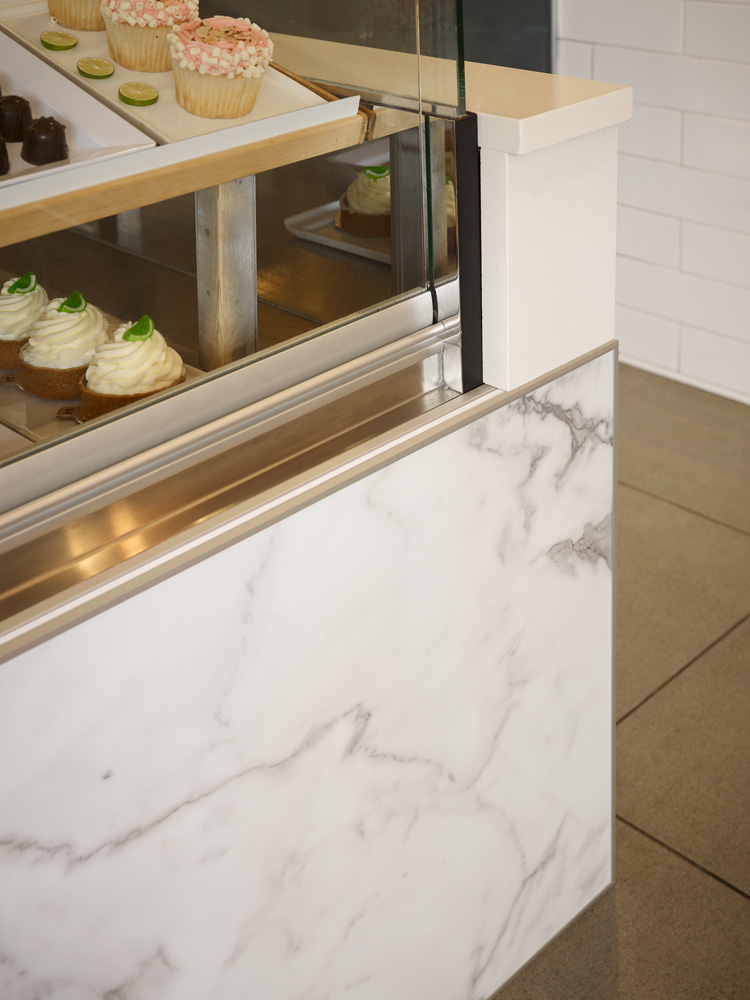
Stylish wall-protection panels can match or coordinate with adjacent surfaces to enhance the overall design aesthetic.
Consider hard walls coordinating with adjacent countertops. This scenario could occur in vast array of settings, from a medical examining room to a classroom or restaurant counter. Notice in these examples the coordination of colors and patterns, which is achieved by specifying both products from the same manufacturer.
Or consider a durable backsplash coordinating with an adjacent countertop. It is easy to picture this scenario in a commercial office break room, restaurant service area, or hotel lobby coffee service. With correct specification, the high-performing protective backsplash can coordinate perfectly with the countertop.
Types of Protective Wall Treatments and Their Strengths and Weaknesses
The designer or specifier must choose from several types of wall protection for commercial spaces. This section discusses various types of materials, with particular emphasis on their strengths and weaknesses.
Following are the most common choices for the designer or specifier. We will look at each of them separately.
- Wall coverings
- Fiber-reinforced laminate (FRL)
- Polyvinyl chloride (PETG/PVC)
- Fiber- or fiberglass-reinforced plastic (FRP)
- Decorative protection wall panels with a fiberglass core
Wall Coverings
High-quality, advanced wall coverings seem like a natural choice for creating more durable walls. Specialized wallcoverings can provide some impact resistance. They are flexible, and come in large rolls for fewer seams.
However, while the wall-covering material itself is impact resistant, the wall behind can dent with impact, defeating the specifier’s main goals. Also, with a relatively soft surface, they are quite easy to scratch, mar, tear, and scuff. And because they are generally made of vinyl, they will not be the first choice for many designers. It would be rare to find one that has a GREENGUARD certification.
In terms of installation, the long rolls and minimum seams are a plus. But they must be installed by an experienced wall-covering installer. Generally, the wall must be primed 72 hours in advance of installation, and pre-pasted 24 hours in advance, which may affect the schedule. And of course, bubbles may occur.
Fiber-Reinforced Laminate (FRL)
Fiber-reinforced laminate (FRL) panels combine fiberglass and Kraft paper in the core construction with their melamine surface to offer a high level of scratch and mar resistance for walls in commercial applications. They are often available in a wide range of stylish designs.
In terms of impact resistance, they offer less protection than other choices. The dimensional stability may be less than stellar because of the Kraft paper within the core. The hybrid core construction can lead to delamination. Fire resistance tends to be less than Class A rating required for commercial settings.
For installation, FRL products can often be attached directly to drywall but are typically not recommended for use with other substrates. They may require a 72-hour acclimation time before installing, rather than the 24-hour acclimation period of other choices.
Polyethylene Terephthalate Glycol/Polyvinyl Chloride (PETG/PVC) Products
Polyethylene terephthalate glycol/polyvinyl chloride (PETG/PVC) products are attractive as wall protection because they are lightweight and offer good impact resistance. They are also priced as much as 50 percent lower than other choices.
For commercial applications, however, the lack of a Class A fire rating is the big concern. These products burn, drip, and can create a toxic environment; some at a rapid rate. The relatively soft surfaces are easy to scratch, mar, and scuff. Due to their composition and off-gassing, they are not likely to have a GREENGUARD certification.
Installation can be tricky for PETG/PVC panels because of their thinness. Tearing of sheets is not uncommon, and sheets must be moved by two people in order not to kink the product. These products can be glued to drywall, but new drywall must be sanded and primed first. After adhesive is rolled on, the installer must go over entire sheets for air bubbles and reroll if necessary. In some cases, if bubbles cannot be resolved, the sheet must be removed and cannot be reused.
Fiber- or Fiberglass-Reinforced Plastic (FRP)
For lower budget projects, the specifier’s attention might go straight to fiber-reinforced or fiberglass-reinforced plastic (FRP). The price is very low, sometimes 75 percent lower than higher-quality products. The impact resistance is a strong positive factor. It is often used in back-of-house service areas.
On the down side, the design selection of FRP panels tends to be quite limited. And while the impact resistance is good, the relatively soft surface will be easy to scratch, mar, and scuff.
Installation of FRP may require more expertise, as the product radiates imperfections in the substrate, and extra layers of mud may be required on the drywall.
Decorative Protection Wall Panels with a Fiberglass Core
Decorative protection wall panels with an entire fiberglass core are a next-level version of high-pressure laminate, or HPL, which is considered to be one of the most durable decorative surface materials and is available with special performance properties, including chemical, fire, and wear resistance. While traditional HPL is based on a very strong layer of Kraft paper (whose name is taken from the German word Kraft, which means force in that language), the newest generation of HPL for wall protection has a fiberglass core. Fiberglass is a reinforced plastic material composed of woven material embedded with glass fibers randomly laid across each other and held together with a binding substance. Fiberglass is combined with resin to form an exceptionally strong and durable composite.
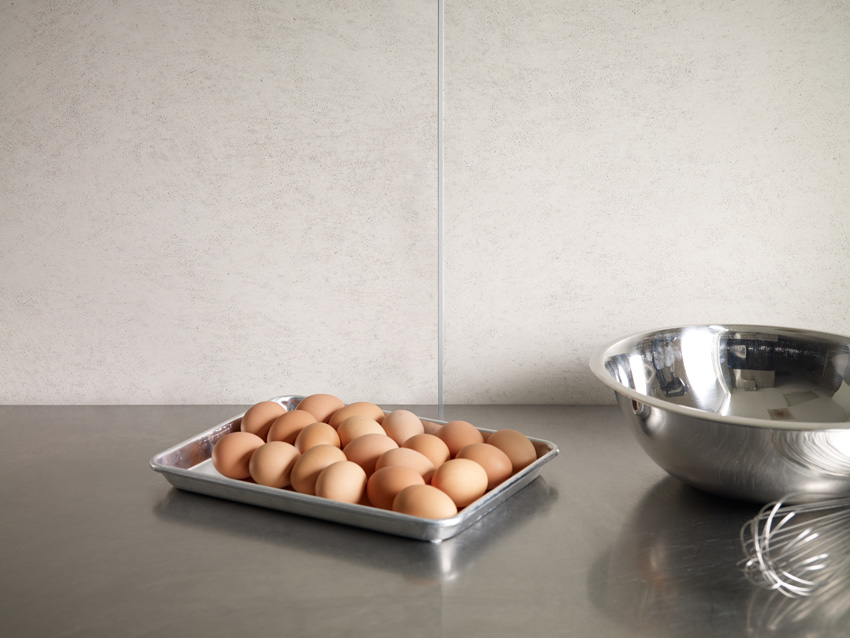
The fiberglass core makes the new generation of decorative protection wall panels extremely resilient.
Decorative protection wall panels with an entire fiberglass core have a Class A fire rating. This makes them ideal for such applications as elevators. They are extremely impact resistant and dimensionally stable. They are scratch, stain, and chemical resistant. They are also, thanks to the fiberglass core, water resistant and easy to clean. They are likely to be available in the manufacturer’s full palette of colors to coordinate with other laminate and solid-surface products.

The decorative protection panels can be applied to so many substrates, thus giving the designer and contractor more flexibility.
Decorative protection panels can be applied to a variety of substrates, including:
- Level 3 finished or painted drywall
- Non-painted drywall and gypsum board
- Plywood
- Above-grade brick and concrete block
- Above-grade poured concrete
- MDF or particleboard
- Inorganic reinforced cement board, also referred to as IRCB or HardieBacker®
- Nonporous material such as tile or metal
For the best and smoothest covering to poured concrete, the wall should be furred out with furring strips or studs and covered with drywall, gypsum board, or cement board. The panels are attached to the wall with adhesive that covers 100 percent of the panel back for trouble free adhesion.
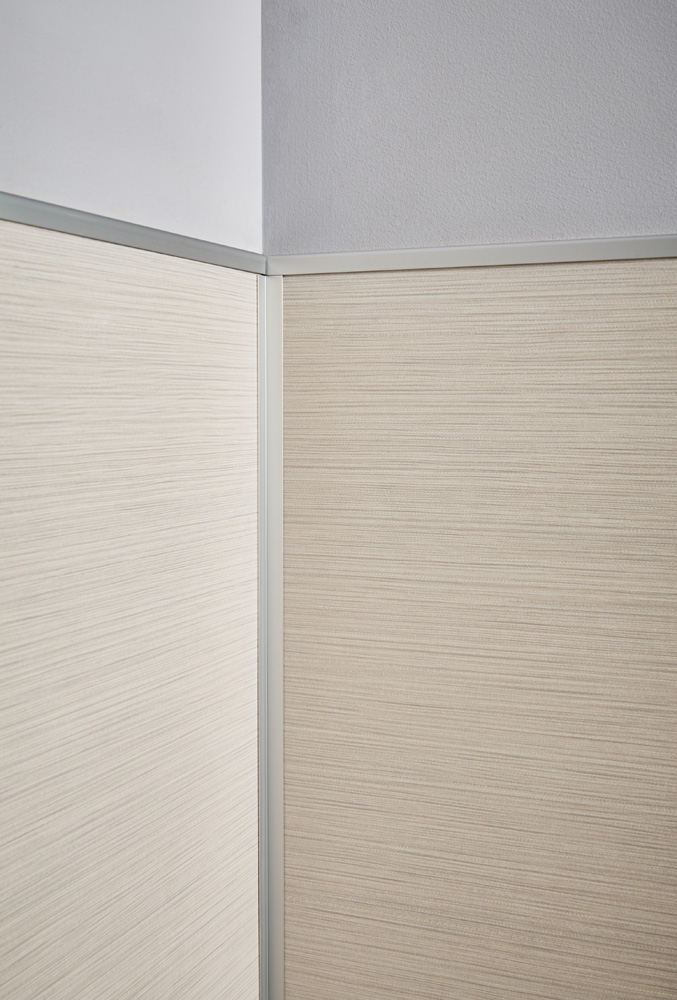
Seam treatments include anodized aluminum trims in both clear and a variety of colors. Another option is color-coordinated 100 percent silicone caulk.
Decorative protection panels are installed using a selection of seam treatments. Depending on the manufacturer, choices may include a variety of anodized aluminum trims with such profiles as inside corner, outside corner, division bar, end cap, and corner guard. The profiles may be available in such anodized colors including clear, champagne, light bronze, dark bronze, and black. Another seam treatment option would be to use color-coordinated 100 percent silicone caulk.
Testing, Standards, and Certifications for Protective Wall Panels
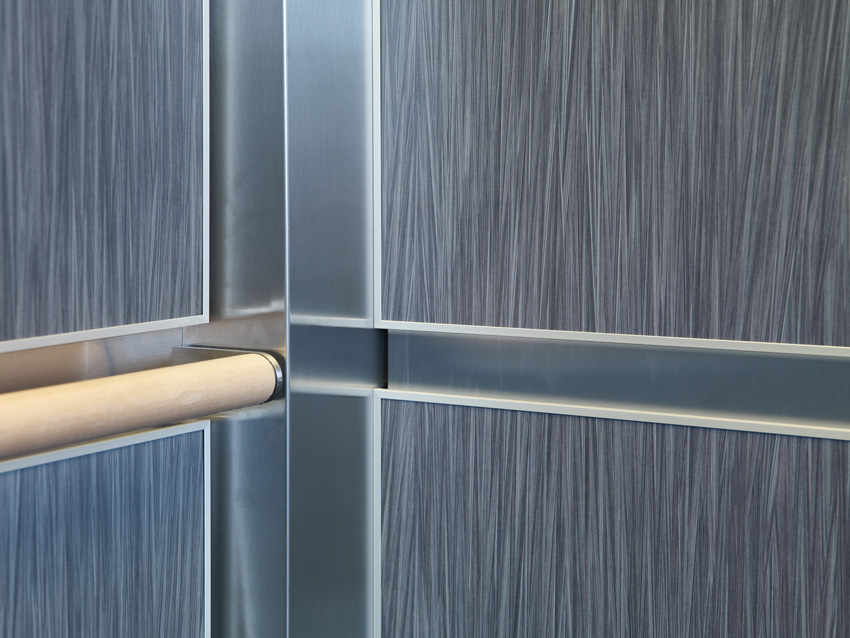
Protection panels must be tested and verified according to strength, fire rating, etc. to be used in commercial applications.
Decorative protection panels must be tested and verified by third-party labs to ensure the protection desired. Following are some testing procedures and results to consider for decorative protection panels.
ANSI/NEMA LD 3-2005
This standard was developed by the American National Standards Institute (ANSI) and the National Electrical Manufacturers Association (NEMA). This standard tests HPL for thickness, performance properties, and appearance.
For best results, specify a product with a “Pass” rating.
Barcol Hardness Test: ASTM D2583-13a
This is the Standard Test Method for Indentation Hardness of Rigid Plastics by Means of a Barcol Impressor. Test Procedure. The specimen is placed under the indentor of the Barcol hardness tester, and a uniform pressure is applied to the specimen until the dial indication reaches a maximum. The depth of the penetration is converted into absolute Barcol numbers.
Barcol hardness is measured on a scale from 0 to 100. Examples of hardness include:
- 35: Polystyrene panels
- 30–40: Plastic swimming pool liner
- 35: Boat repair gel coat
- 36.5: Fiberglass
- 50: Protruded polyester
- 65: Solid surface
- 72: Decorative protection panels with a fiberglass core
For best results in specifying decorative protection panels, choose a product with a high Barcol hardness rating (www.barcol-impressor.com/examples.htm).
Ball Impact Resistance: NEMA LD3.8
In this test, an 8-ounce (224-gram) steel ball is dropped from a certain height with no surface fracture in three replicate drops. The higher the number of inches in the result, the more resistant the material is to fracture.
Examples of impact resistance include:
- 36 inches: Solid surfacing
- 53 inches: Decorative protection panels with a fiberglass core
Fire E84 Class A
This is the Standard Test Method for Surface Burning Characteristics of Building Materials.
The most stringent rating available for building materials is Class A. Class A materials have a flame spread rating (FSR) of 0 to 25. Flame spread is used to describe the surface burning characteristics of building materials and is one of the most tested fire performance properties of a material. The test for flame spread is sometimes referred to as the Steiner tunnel test. This test is applicable to exposed surfaces such as walls and ceilings.
For best results when specifying decorative protection panels, choose a product with a Class A fire rating.
Chemical Spot Test: SEFA 8.1
This test was developed by the Scientific Equipment & Furniture Association to evaluate the resistance a finish has to chemical spills. The procedure tests samples for chemical resistance using 49 different chemical reagents. The results of the test constitute the rating system:
- Level 0: No detectable change
- Level 1: Slight change in color or gloss
- Level 2: Slight surface etching or severe staining
- Level 3: Pitting, cratering, swelling, or erosion of coating; obvious and significant deterioration
For best results in specifying a high-pressure decorative laminate for vertical surfaces, choose a product with a rating of 0.
Bacterial Growth Resistance: ASTM-G22
This is the Standard Practice for Determining Resistance of Plastics to Bacteria.
This is especially important for health care, food services, or any location where human and material contact will be present. In this test, the material is inoculated with various bacteria and intubated at 95 degrees Fahrenheit (35 degrees Celsius) at 85 percent humidity. After the period, the material is examined to determine if any growth of the bacteria has occurred.
For best results, choose a product whose ASTM-G22 results are: “No growth observed.”
GREENGUARD Gold Certification
According to GREENGUARD, the Gold Certification standard “includes health-based criteria for additional chemicals and also requires lower total VOC emissions levels to help ensure that products are acceptable for use in environments like schools and health-care facilities.”
For best results, choose a product with a GREENGUARDGold Certification
Other Laminate Choices for Vertical Surfaces
Besides decorative protection panels, a number of other options are available for walls. They include metal laminates, writable laminates, and custom laminates. Let’s look at examples of each.
Metal Laminate Wall Panels
Metal laminate wall panels deliver lustrous color and sheen with textures reflecting energy, modernity, and a feel for craftsmanship. They are useful for adding flair to vertical applications for walls, furniture, retail fixtures, signage, exhibits, and displays.
Writable Laminates
Writable laminates have many uses in the commercial and health-care fields. In a nurses’ station, for instance, laminates that can be written on can become the center of communication for the caregivers, where clear communications can be a life and death matter. In patient rooms, writable walls can also enhance communications between various health-care specialists that visit during the day. The walls can also serve as a communication tool and mood brightener with messages left by visiting family and friends. In a restaurant kitchen, a writable wall can contain a running list of supplies needed or clearly indicate the tasks for the day. The same could be said for a retail store’s back room. The following case study shows how writable walls brought value to a design firm’s office.

Writable laminates foster better communications in health-care settings.
Custom Laminates
Custom laminates for vertical applications tap into designer creativity and solve many problems, from creating a unique environment to supporting client branding. Custom laminates can be based on an original design, photograph, painting, or any other artwork.
Conclusion
The need for durable design and interiors makes decorative protection panels a good option for many commercial and public spaces, including restaurants, schools, museums, public buildings, offices, and more. While standard laminates are based on a Kraft paper core, these upgraded panels contain a fiberglass core. Rigorous testing results indicate these protection panels are indeed more resistant to impacts. Other types of panels are available for vertical surfaces, including metal laminates, write-upon surfaces, and custom laminates. Each has its own qualities to increase a project’s appeal and functionality. As a final consideration, the designer is wise to specify all surfacing products, from walls to countertops to backsplashes, from the same manufacture to ensure the seamless coordination of colors and patterns. With the correct specification, projects with these specialty panels are sure to bring positive attention to both the business and designer.




